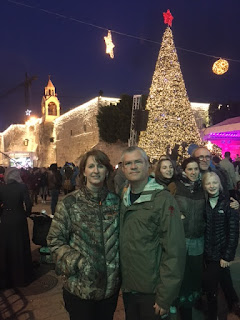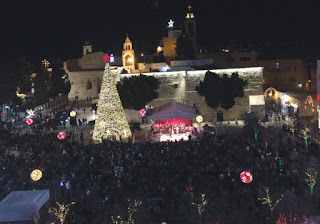Joseph and I snuck out for the afternoon to the Old City one more time between rain showers and spent a few hours exploring the Armenian quarter, and we enjoyed seeing the Cardo area with its Roman ruins and unique shopping area. Our main destination was the Church of St. Mark, which many believe was the site of the Last Supper and later the first Christian church established by St. Mark. Joseph and I were the only ones there for a visit and one of the sisters was happy to spend almost an hour with us telling stories about the history of the church and the pilgrims that have sought healing there over the centuries. On the way back to the Jaffa Gate, we stopped at our favorite falafel joint for one more stuffed pita before walking back to the First Station area one last time. I will never forget the walls of the Old City and the winding streets and alleys within that could burst from the historical events that happened there and changed the world forever.
The Cardo
At 8:00 the next morning, we locked the door to apartment number four and stood on the street corner in the cold wind trying to hail one last taxi in Jerusalem. A minivan finally pulled over and we crammed our stuff in the back and jumped in out the cold. Our driver was a cheerful, bald-headed man in his fifties who had his twenty-something daughter in the passenger seat for the purpose of taking her to work. Their English was excellent, and we had a spirited discussion about our time in Israel, and we all lamented spending so much money on groceries and basic necessities. Our driver mentioned that things were becoming more dangerous in Jerusalem, and he said, "Ees important I carry one of these," as he reached behind his back and pulled a nine millimeter pistol from his waistband for all to see. His daughter rolled her eyes as he showed us his gun, and we all concurred that it was a fine weapon indeed. He dropped his daughter off, and we rode with him for another ten minutes to the central bus station and filled the time talking about Israel's strict gun laws before entering the huge complex full of early morning passengers and young men and women in military uniform carrying very large weapons. We pushed our bags through the scanner at the first of many security checks of the day.
Deena and I purchased tickets for the 961 bus leaving at 9:00 for Bet She'an, the site of the incredible ruins we visited a few weeks ago and for the Jordan River border crossing from Israel into Jordan, our next destination. The two-hour ride was comfortable, and I looked out the window the whole time watching the terrain change from barren, bleached limestone hills to the green Jordan River Valley surrounded by the mountains we came to love in Galilee. There were settlements and small villages along the way, and modern-day shepherds guided their flocks among heavy farm machinery in areas full of long low greenhouses and vineyards shielded with plastic. There were a few cornfields tucked in between huge groves of palm trees planted in tight rows—the smaller trees covered with plastic barriers to keep out the cold weather. The bus made stops regularly along the way and male and female gun-toting soldiers were the primary passengers getting on and off the bus. The bus pulled off the highway at the small Bet She'an terminal, and all the passengers exited to desolate streets and small closed shops in a place that Joseph said looked like an outpost at the end of the world. A group of girls snagged the only taxi before we could get to it, but the driver radioed his buddy to come pick us up. A few minutes later after a brief ride, we were walking up to the heavily guarded border station, where we proffered our passports for the first of many of such presentations that day.
We began a three-hour process at the Israeli compound, where we paid our exit fees, got our passports stamped, changed our shekels for Jordanian dollars, and walked outside to the small station, where a bus picked us up with a bunch of other border hoppers and drove us three minutes over the Jordan river and into the sovereign nation of Jordan with the confident smile of King Abdullah the Second greeting us from a large banner at the checkpoint. Two heavily-armed officers boarded the bus and did a thorough check of passports before allowing us to continue to the compound where more officials took our money for visas and took our pictures for their files. We managed to sneak outside and eat the chicken pita lunch we had packed in the shade under a row of Jordanian flags popping in the stiff breeze. Finally, we were officially in Jordan, but not for long, as we waited for a taxi to pick us up and drive us two hours to the Queen Alia airport south of Amman for our flight to Cairo. We had to wait about thirty minutes for our taxi, so we sat in the warm sunshine on the curb next to the cabstand and teased each other good naturedly as we talked about some of our adventures so far. Our driver, Ha'ed, showed up, and we were off into the heart of Jordan as the day wore on.
The small villages weren't much to look at as we passed by crumbling buildings and streets full of trash, but the locals all seemed to be in a good mood as they ran across the road in and out of traffic. There were long stretches of road lined with families as they cooked meals over small propane stoves and relaxed in lawn chairs while they talked and watched traffic whiz by. Halfway through the journey, Ha'ed stopped at a small shop for an all-American snack of a cup of coffee and a Marlboro, and he returned to the car carrying the largest head of romaine lettuce I've ever seen. He opened his door, peeled off the outer leaves exposing the tender, inner sections of the lettuce and presented it to me with a huge smile as he said, "Welcome to Jordan" enthusiastically. So, off we went, climbing the mountain range leading away from the Jordan River munching our gift of lettuce. The mountains were steep with distant ridges hazy in the late afternoon sun, and we headed down the other side and approached the capital city of Amman, which is a sprawling modern metropolis and our home for eight days after we return from a three-day trip to Cairo.
Ha'ed dropped us off at the airport at 4:30. We checked in at the Royal Jordanian desk, received our boarding passes and were informed that our 6:45 flight was delayed for an hour, sighhh. A big honkin' cup of Starbucks coffee and quarter pounder with cheese helped pass the time after Deveny almost got us thrown into a Jordanian jail at security. She still had several expired hand warmers in her coat pocket left over from Christmas Eve in Bethlehem, and we had to sit quietly while a committee of security guards held our passports and launched an investigation into hand warmers, which they had never seen before. I wish I had taken a video of Deena trying to explain their use like she was playing a game of charades while the security guys tried not to laugh. We were finally freed to wait out the remainder of our delay at the gate as the day just kept getting longer.
The boarding process went smoothly and before long, we were in the air taking the long way to Egypt by flying along the Israeli border—an Arab airline flying over Israeli airspace is a big no-no. On the flight we were served a small meal which was pretty good, and we landed in Cairo with more security checks, visas to purchase, and more money to extract from the ATM. It was 11:15 PM by the time we met our Uber driver, and he navigated toward the Giza Plateau as he talked to our host, Ashti, several times on the phone. We made it to our street at midnight and Ashti was waving at us with a big smile on his face. After we paid the driver, and he left, Ashti said, "I don't know what's wrong with thees guy. He don't know where the Sphinx is. The Sphinx been there for five-thousand years, and he cannot find the Sphinx." Ashti and his family own a building about two-hundred meters from the entrance to the pyramid complex, and our apartment balcony has a million-dollar view right across the whole amazing thing. Ashti got us settled and bid us goodnight with the promise of touring the neighborhood in the morning. We stood on the balcony gazing on the pyramids illuminated by soft purple flood filters seventeen hours after we began our journey from Jerusalem. After we fell into bed, I lay awake for a bit thinking about my little family and the things we've accomplished on this trip so far. On long travel days full of challenges and test of stamina, I'm thankful for the positive attitude that continues to prevail and the tenacity in working together to win some hard-to-reach but worthy destinations.





































